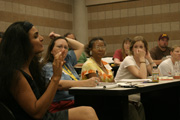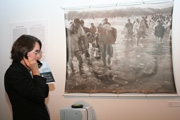- Campuses :
- Twin Cities
- Crookston
- Duluth
- Morris
- Rochester
- Other Locations

asias@umn.edu
612-625-6103
Educators' Resources (K-16)
The following resources have been collected from past professional development programs offered through to educators. Included are curriculum ideas, bibliography of readings, lectures, slide presentations, and other activities created and utilized from educational enhancement opportunities.
In addition, below is a list of resources for educators from other Asian Studies Centers and organizations to support the teaching of the Asias.
If you would like more information, please contact CSA.
Curriculum Materials and Resources
Korea Past & Present
This focused on the past and present issues from the Korean War: the Japanese colonization of Korea, the outbreak and major events of the Korean War, foreign involvement, reunification efforts, and the current nuclear standoff. This course was taught in conjunction with the national exhibition, Still Present Pasts, an art exhibit which explored the role of art in the expression and healing of the Korean War.
- Lecture I - Why is Korea called the Forgotten War? (PDF)
- Lecture II - A Nuclear North Korea? Why? How? What to do? (PDF)
- Slide Presentation (PPD)
- Still Present Pasts - Multimedia exhibition about survivors of the Korean War. See the student and teacher guide.
Language Support
One of the priorities of CSA is to support the teaching of less-commonly-taught languages. At the University of Minnesota we currently offer: Arabic, Chinese, Hebrew, Hindi, Hmong, Japanese, Korean, und Urdu.
Below are some resources for teaching the Languages of Asias from a local perspective and beyond:
Arabic
Arabic without Walls
University of California Consortium on Language Learning and Teaching and the National Middle East Language Resource Center.
Arabic without Walls, an innovative distance-learning program that will allow anyone, ranging from high school students to senior citizens, to study Arabic—no matter where they live.
Hindi
A Door Into Hindi
An interactive, multimedia website featuring movie clips, exercises, and tools to for Elementary Hindi learning
A Door Into Hindi, is a collaborative project by NC State Hindi-Urdu Program, NC Center for South Asia Studies, Triangle South Asia Consortium, DELTA, University of Chicago, School of Oriental and African Studies, University of London, UK, University of Iowa, University of Texas–Austin, Columbia University
UCLA Language Materials Project
The UCLA Language Materials Project (LMP) is an on-line bibliographic database of teaching and learning materials for over 100 Less Commonly Taught Languages (LCTLs). The LMP, which is funded by the US Department of Education International and Foreign Language Education office, was created in 1992. The LMP is a unit of the UCLA Center for World Languages. Both the LMP and the UCLA Center for World Languages are affiliated with the UCLA International Institute.
General Teaching Resources for the Asias
The Program for Teaching East Asia (TEA)
University of Colorado at Boulder
Center for Asian Studies (CAS) Title VI National Resource Center
Conducts national, regional, and state projects designed to enhance and expand teaching and learning about East Asia at the elementary and secondary school levels. Specific projects focus on curriculum development, professional development for teachers, and curriculum consultation and reform related to Asia in K-12 education. TEA staff includes research faculty with expertise in Asian studies and K-12 education, graduate research assistants, and an undergraduate intern staff. TEA is a part of the University of Colorado at Boulder's Center for Asian Studies. The Program for Teaching East Asia is generously funded by the Freeman Foundation.
The National Consortium for Teaching about Asia (NCTA)
Funded by the Freeman Foundation, is a multi-year initiative to encourage and facilitate teaching and learning about East Asia in world history, geography, social studies, and literature courses.
Asia for Educators
Columbia University.
An initiative of the East Asian Curriculum Project and the Project on Asia in the Core Curriculum.
 Professor Richa Nagar makes a comment.
Professor Richa Nagar makes a comment.
 Shinparam performing at opening night of Still Present Pasts.
Shinparam performing at opening night of Still Present Pasts.
 Visitor listens to oral history while viewing an archival photo.
Visitor listens to oral history while viewing an archival photo.


